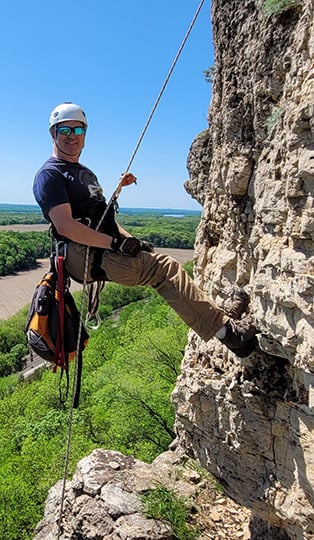
John Howe, RRP Director
Welcome – this year is coming to a close and I can’t help but look back with a feeling of accomplishment. It has seemed like a tough couple of years and I am ready for some R&R. You may think I’m referring to Rest & Relaxation. Yes, we can all use that, but I’m thinking about Renewal and Research. Life can be harsh in the natural world, and we have followed many recent changes and challenges that have led to opportunities for renewal and research.
Renewal: After over ten years of watching and learning from Mom and Dad Decorah, our Decorah Eagles decided to do what wild animals do – move on. Moving away from our watchful camera lenses was and still is a tough pill to swallow, but it is part of a natural progression that we can’t control. While we have been able to track them with photographs from afar, it has not been the same. That natural progression has led to an opportunity for Renewal. We shifted our focus to our eagles in the valley of the Norths – the Decorah North Nest. And then after ten years away from the famous Decorah Eagle nest known as N1, we have a new pair of eagles entering the territory that are calling it home! What an exciting time, and I think we are very fortunate to be starting the bald eagle love story all over again. Who knows what the coming nesting season will bring? Eaglets, we hope.
Research: Regarding our raptor research, we have added an entirely new program this year monitoring and tracking the golden eagle population that winters in the Driftless Area. I’m excited to report that we captured two golden eagles our first year and I’m very proud of our team and the prospects for expanding our program in the coming year. Every day is an exciting day of data as we learn more about these powerful and mysterious raptors. Read all about it in the Program Spotlight Section! Our peregrine falcon monitoring crew went above and beyond this year implementing field work as highly pathogenic avian influenza (HPAI) entered the picture. We recorded excellent information to help assess its impact on the peregrine population with pre-nest season monitoring, focused banding of young, and follow-up monitoring. The good news is that we did not observe any HPAI cases and production was normal across the territory. I wish I could say the same for owl and bald eagle populations where HPAI cases were reported to be much more prevalent. With the onset of HPAI in raptor populations, the importance of our peregrine falcon monitoring program is clear. Time will tell how lasting the effects of HPAI are and which raptor populations it circulates through. Managing and minimizing our human impact on raptor habitat in the years to come will be critical to their survival, which means that our mission of education, stewardship, and creating a lasting connection between our two worlds has never been so important.
I want to close by recognizing our partners that help us deliver our mission. Our live cams, education programs, and research would not be possible without your partnership. I’m proud of the contribution our teachers, volunteers, and conservation partners make. Thank you for supporting our programs, your interest, and your valuable contribution.
 The Raptor Resource Project
The Raptor Resource Project The Raptor Resource Project
The Raptor Resource Project